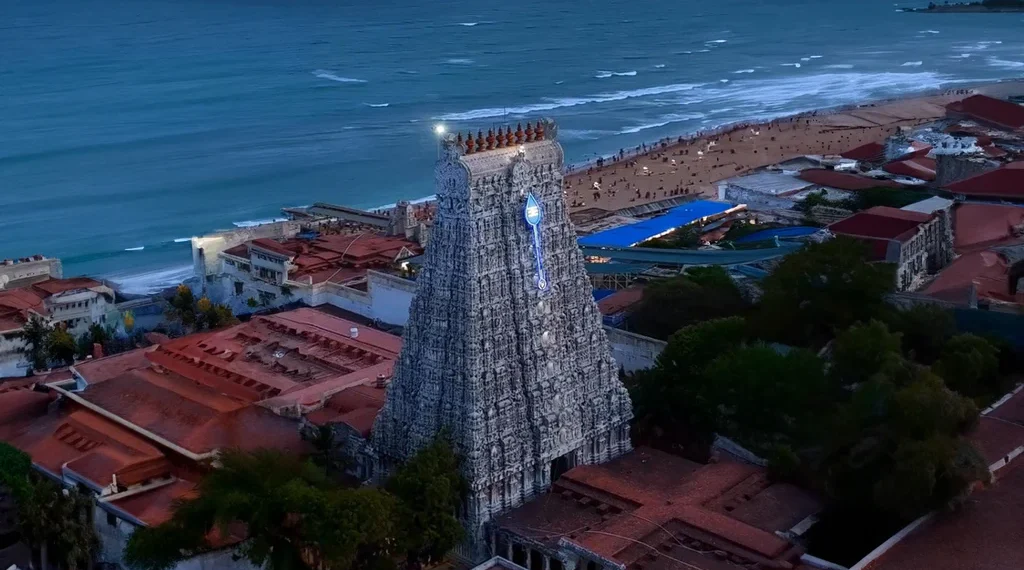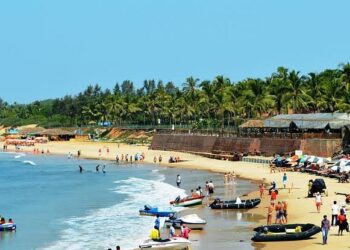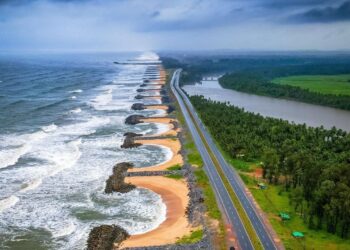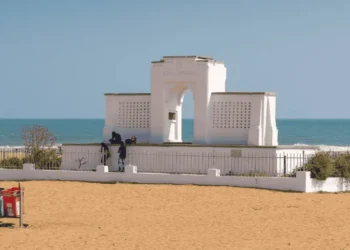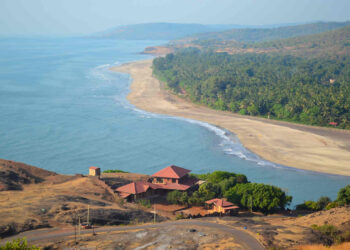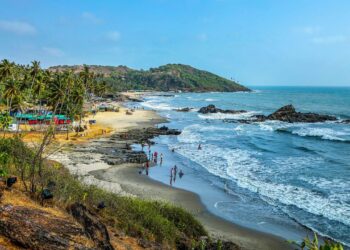The Thiruchendur Murugan Temple located in Tiruchendur, Tamil Nadu, right along the Bay of Bengal’s shore in Thoothukudi district, is about 40 km from Tuticorin and 75 km from Kanyakumari. It’s a holy place(Kshetra) for Lord Murugan, the god of war, worshipped as Subramania Swamy or Senthil Andavar. This temple, one of the six Arupadai Veedu (abodes of Murugan), is special for being by the sea, unlike the others on hills. Covering about 7 acres, its towering gopuram and carved halls draw pilgrims, historians, and visitors who can feel the palpable power.
Legend of the temple
The temple’s story comes from the Skanda Puranam. Long ago, a demon named Surapadma got a blessing from Lord Shiva after hard penance, making him nearly unbeatable except by Shiva’s son. He turned cruel, ruling an ocean fortress called Veera Mahendrapuri, troubling gods, and jailing Indra, their king. The gods asked Shiva for help, and from his third eye came six sparks. These sparks, carried by the Ganges to Saravana Poigai lake, became six babies, raised by Krithika nymphs. When Goddess Parvati hugged them, they joined into one god with six faces and twelve arms, called Arumuga or Shanmukha—Lord Murugan.
Shiva told Murugan to defeat Surapadma. Murugan came to Thiruchendur with his army, led by Veerabahu. He sent Veerabahu to ask Surapadma to free the gods, but the demon refused. A big battle followed. Over five days, Murugan’s army killed Surapadma’s brothers and soldiers. On the sixth day, Murugan fought Surapadma, who turned into a mango tree to hide. Murugan’s spear split the tree, and Surapadma became a peacock and a rooster. Murugan spared him, making the peacock his ride and the rooster his flag. After the victory, Murugan prayed to Shiva, and the divine architect Mayan built this temple to mark the win. This battle is celebrated as Skanda Shasti, a big festival here.
History of Thiruchendur Murugan Temple
The temple’s past is old, mentioned in the 3rd-century Tirumurugatrupadai by Nakkirar, calling it a key Murugan shrine. Worship here might go back further, tied to Tamil traditions. The building we see started around the 8th century, growing over time. The Pallava kings, from the 6th to 9th centuries, likely began it, with inscriptions from 875 CE showing their work. The Pandya kings, from the 6th to 14th centuries, added to it, and the Chera kings helped too.
The Chola kings, from the 9th to 13th centuries, brought carvings and halls. By the 10th century, it was a busy spot, with fishermen and traders supporting it, as old records show. The Vijayanagara kings, from the 14th to 16th centuries, made it grander. The temple faced trouble in the 1300s from northern invaders, but priests kept it safe. In the 17th century, the Dutch took the temple from 1646 to 1648 during their war with the Portuguese. They looted idols, thinking they were gold, but a storm hit their ship. They threw the idols into the sea, and the storm stopped. In 1653, a devotee named Vadamaliyappa Pillai, guided by Murugan in a dream, found the idols and brought them back, as shown in temple paintings.
A miracle came in 2004 when the tsunami spared the temple while damaging nearby areas, adding to its legend. From 1868 to 1941, three saints—Mauna Swami, Kasi Swami, and Arumuga Swami—rebuilt it after sea air wore down the sandstone, finishing with a grand kumbhabhishekam in 1941.
Architecture of the Temple
The Thiruchendur Murugan Temple is Dravidian style, covering 299 feet north to south and 213 feet east to west. Its Mela Gopuram, on the western side due to the nearby sea, is 137 feet tall with nine tiers, marked by nine kalasams (sacred pots). Unlike most Tamil temples with eastern gopurams, this one faces south, opening to the Sivili Mandapam, a hall with rows of yali columns showing symmetry.
The sanctum, carved into a cave, holds Murugan as a child, called Balasubramania Swamy, facing east, and another idol, Shanmukhar, facing south. The Avast Mandapam has 124 carved pillars, each a work of art. The Vasanta Mandapam, on 120 columns, and the Ananda Vilas Mandapam, with 16 black granite pillars overlooking the sea, add beauty. Shrines for Valli, Deivanai, Vishnu as Venkatesa, and Shiva as Kashi Vishwanath are in the praharams. The Nazhi Kinaru, a well 100 meters south, gives fresh water despite being near the sea, used for ritual baths after sea dips. The temple’s red sandstone base, from local hills called Kanda Madana Parvata, gives Tiruchendur its name, meaning “red region.”
Religious Significance and Festivals
For Murugan devotees, this temple is a top pilgrimage site, the second of the six Arupadai Veedu, named in the Tirumurugatrupadai. The story of Murugan’s victory over Surapadma makes it a place to seek strength and peace. It’s a Vaippu Sthalam, sung by saint Appar, adding to its Saiva importance. Pilgrims bathe in the sea and Nazhi Kinaru before praying, offering milk pots or hair as vows. The temple’s survival of the 2004 tsunami is seen as Murugan’s protection, deepening its holiness. People pray for courage, success, or children, feeling Murugan’s power in the sea breeze.
Festivals bring the temple to life. Skanda Shasti, in October or November, is the biggest, marking Murugan’s win over Surapadma. For six days, devotees fast, and on the sixth, Soorasamharam reenacts the battle on the shore. The seventh day celebrates Murugan’s wedding to Deivanai, called Thirukalyanam. Masi Brahmotsavam, in February or March, lasts 12 days with processions, drawing lakhs. Avani Brahmotsavam, in August or September, is also grand. Adi Krithigai, Thai Poosam, and Panguni Uthiram are other big days. Nine daily poojas, from 5:10 AM Subrapadam to 8:45 PM Palliarai, include offerings like pongal and appam, keeping the temple’s rhythm.
Cultural and Modern Importance
The temple is a center of Tamil culture. Hymns by saints like Arunagirinathar in Tiruppukazh and Adi Shankara’s Subramanya Bhujangam—written here to cure his illness—tie it to Tamil devotion. Festivals bring Tamil music, dance, and processions, keeping arts alive. The carvings and pillars show stories from long ago, like Murugan’s battle. Today, it draws people from India, Singapore, Malaysia, and beyond. It’s open from 5 AM to 9 PM, with special darshan at ₹100. Visitors can stay in temple-run lodges like Senthil Andavan Viduthi or nearby hotels. The temple is 60 km from Tirunelveli, with buses and trains from Chennai or Madurai. Pilgrims enjoy the beach and local treats like kadali mittai.
Conclusion
The Thiruchendur Murugan Temple is a must visit Kshetra in South India for Murugan devotees whose divine presence permeate the whole place from the stones to the majestic caves calling thousands who seek Lord Murugan’s blessings and his grace.
